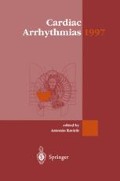Abstract
In typical human counterclockwise or clockwise atrial flutter, the barriers of the right atrial reentrant circuit are reasonably well established, and curative ablation with a high rate of success is available for this arrhythmia [1–7]. Atrial fibrillation has long been described as a disorganized or random phenomenon [8]. Recent studies, however, found evidence that the activation during atrial fibrillation is not entirely random [9], suggesting similarities among these common arrhythmias. In an animal model, the conversion of atrial fibrillation into atrial flutter and back has been shown to occur spontaneously [10]. In humans, however, the conversion of one arrhythmia into the other has not been extensively analyzed, although recent studies found evidence that especially atrial fibrillation may spontaneously convert into atrial flutter [11, 12]. Thus, in the present article, we will review the role of atrial anatomy for the relationship between atrial fibrillation and atrial flutter and its consequences for diagnosis and treatment.
Access this chapter
Tax calculation will be finalised at checkout
Purchases are for personal use only
Preview
Unable to display preview. Download preview PDF.
References
Kalman JM, Olgin JE, Saxon LA, Fisher WG, Lee RJ, Lesh MD (1996) Activation and entrainment mapping defines the tricuspid annulus as the anterior barrier in typical atrial flutter. Circulation 94: 398–406
Olgin JE, Kalman JM, Fitzpatrick AP, Lesh MD (1995) Role of right atrial endocardial structures as barriers to conduction during human type I atrial flutter: activation and entrainment mapping guided by intracardiac echocardiography. Circulation 92: 1839–1848
Nakagawa H, Lazarra R, Khastgir T et al (1996) Role of the tricuspid annulus and the Eustachian valve/ridge on atrial flutter. Circulation 94: 407–424
Feld GK, Fleck P, Chen PS et al (1992) Radiofrequency catheter ablation for the treatment of human type I atrial flutter. Circulation 86: 1233–1240
Kirkorian G, Moncada E, Chevalier P et al (1994) Radiofrequency ablation of atrial flutter. Circulation 90: 2804–2814
Saoudi N, Nair M, Abdelazziz A et al (1996) Electrocardiographic patterns and results of radiofrequency catheter ablation of clockwise type I atrial flutter. J Cardio-vasc Electrophysiol 7: 931–942
Olgin JE, Kalman JM, Saxon LA, Lee RJ, Lesh MD (1997) Mechanism of initiation of atrial flutter in humans: site of unidirectional block and direction of rotation. J Am Coll Cardiol 29: 376–384
Moe GK (1962) On the multiple wavelet hypothesis of atrial fibrillation. Arch Int Pharmacodyn Ther 140: 183–188
Gerstenfeld EP, Sahakian AV, Swiryn S (1992) Evidence for transient linking of atrial excitation during atrial fibrillation in humans. Circulation 86: 375–382
Ortiz J, Niwano S, Abe H, Rudy Y, Johnson NJ, Waldo AL (1994) Mapping the conversion of atrial flutter to atrial fibrillation and atrial fibrillation to atrial flutter. Insights into mechanisms. Circ Res 74: 882–894
Waldo AL, Cooper TB (1996) Spontaneous onset of type I atrial flutter in patients. J Am Coll Cardiol 28: 707–712
Roithinger FX, Karch MR, Steiner PR, SippensGroenewegen A, Kalman JM, Lesh MD (1997) Spontaneous conversion of atrial fibrillation to flutter in man: a stereotypical pattern of organization. J Am Coll Cardiol 29(2A): 359 (abstr)
Frame L, Page R, Hoffman B (1986) Atrial reentry around an anatomic barrier with a partially refractory excitable gap: a canine model of atrial flutter. Circ Res 58: 495–511
Feld GK, Shahandeh RF (1992) Mechanism of double potentials recorded during sustained atrial flutter in the canine right atrial crush-injury model. Circulation 86: 628–641
Inoue H, Toda I, Saihara S et al (1989) Further observations on entrainment of atrial flutter in the dog. Am Heart J 118: 467–474
Shimizu A, Nozaki A, Rudy Y, Waldo AL (1991) Onset of induced atrial flutter in the canine pericarditis model. J Am Coll Cardiol 17: 1223–1234
Watson RM, Josephson ME (1980) Atrial Flutter. I. Electrophysiologic substrates and modes of initiation and termination. Am J Cardiol 45: 732–740
Kalman JM, Olgin JE, Saxon LA, Lee RJ, Scheinman MM, Lesh MD (1997) Electrocardiographic and electrophysiologic characterization of atypical atrial flutter in man. Use of activation and entrainment mapping and implications for catheter ablation. J Cardiovasc Electrophysiol 8: 121–144
Saffitz JE, Kanter HL, Green KG, Tolley TK, Beyer EC (1994) Tissue-specific determinants of anisotropic conduction velocity in canine atrial and ventricular myocardium. Circ Res 74: 1065–1070
Stambler BS, Wood MA, Ellenbogen KA (1996) Pharmacologic alterations in human type I atrial flutter cycle length and monophasic action potential duration. Evidence of a fully excitable gap in the reentrant circuit. J Am Coll Cardiol 27: 453–461
Movsowitz C, Callans DJ, Schwartzman D, Gottlieb C, Marchlinski FE (1996) The results of atrial flutter ablation in patients with and without a history of atrial fibrillation. Am J Cardiol 78: 93–96
Katritsis D, Iliodromitis E, Fragakis N, Adamopoulos S, Kremastinos D (1996) Ablation therapy of type I atrial flutter may eradicate paroxysmal atrial fibrillation. Am J Cardiol 78: 345–347
Philippon F, Plumb VJ, Epstein AE, Kay GN (1995) The risk of atrial fibrillation following radiofrequency catheter ablation of atrial flutter. Circulation 92: 430–435
Author information
Authors and Affiliations
Editor information
Editors and Affiliations
Rights and permissions
Copyright information
© 1998 Springer-Verlag Italia
About this chapter
Cite this chapter
Lesh, M.D., Roithinger, F.X., Karch, M.R., Steiner, P.R., SippensGroenewegen, A. (1998). What Is the Relationship between Atrial Fibrillation and Flutter in Man?. In: Raviele, A. (eds) Cardiac Arrhythmias 1997. Springer, Milano. https://doi.org/10.1007/978-88-470-2288-1_19
Download citation
DOI: https://doi.org/10.1007/978-88-470-2288-1_19
Publisher Name: Springer, Milano
Print ISBN: 978-88-470-2290-4
Online ISBN: 978-88-470-2288-1
eBook Packages: Springer Book Archive

